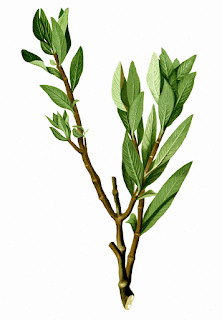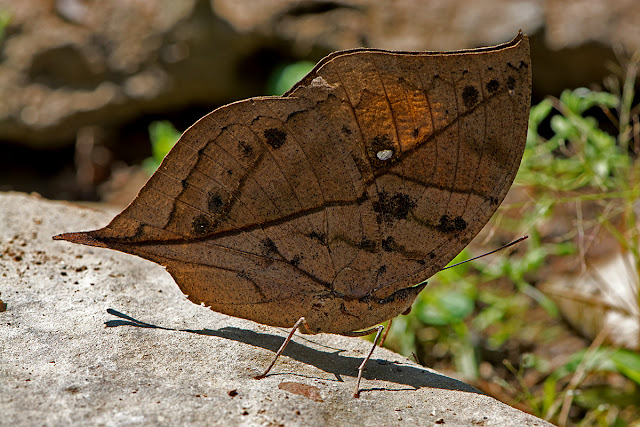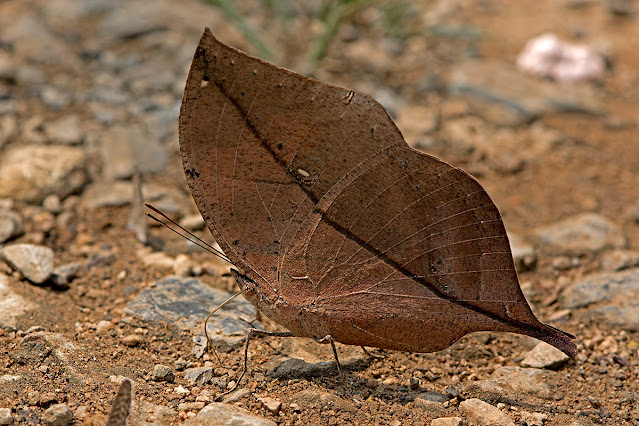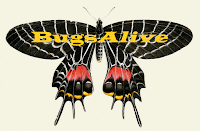Kallima inachus - the Orange Oak Leaf
Written and photographed by Tim Stratford
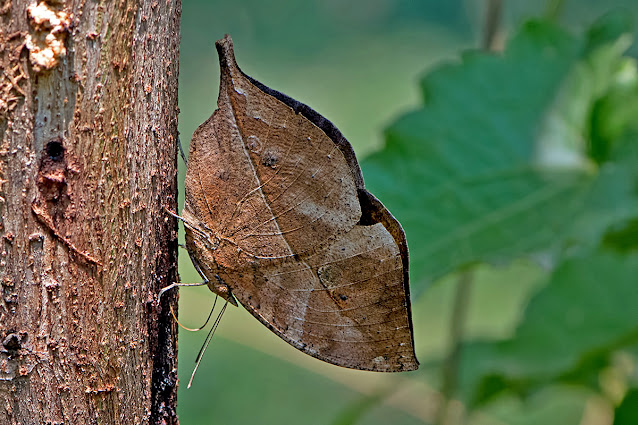 |
| Photo: Doi Suthep-Pui National Park, Chiang Mai, Thailand. 380m a.s.l. |
Introduction
Family: Nymphalidae - Subfamily: Nymphalinae - Genus: Kallima - Species: inachus
This butterfly is real master of camouflage. When its wings are closed it bears a remarkable resemblance to a dead leaf both in colour and shape. It uses this disguise as a means of hiding from predators and when it is on a tree, or on the ground amongst the leaf litter, it is extremely difficult to spot. There are differences in colouration and the cryptic pattern on the underside of the wings varies greatly from one individual to another, making it even harder for predators to recognise it. The veins are often darkened and resemble the central stem and veins of a leaf. However, there is a flaw in this strategy. When the butterfly decides to bask in the sunshine and opens its wings it is no longer hidden because of the much brighter markings on its upperwings. This results in the species being regularly attacked, particularly by birds.
Kallima inachus is a strong flier and a medium-large butterfly with a wingspan of 60-90mm. It is sexually dimorphic and the female is larger than the male with different colouration and a longer point at the forewing apex. The species is polyphenic and there is seasonal variation in its appearance with the wet season form tending to be a little smaller than the dry season form.
Both sexes only occasionally visit flowers for nectar and have a much bigger preference for tree sap and rotting fruit instead. When feeding on sap they typically do so upside down and this enhances the deception that they are a dead leaf. Animal dung is also visited and males are frequently seen puddling for minerals. Its common name varies depending where you are but is most often called the Orange Oak Leaf or Dead Leaf Butterfly.
Distribution & Seasonality
Kallima inachus has a fairly limited range and distribution is from Nepal in the west, through north-east India, Bhutan, Bangladesh, Myanmar, Thailand, Laos, and Vietnam, to southern China and Taiwan in the east. The species can be quite abundant in northern India but appears to become rarer as it spreads eastward, especially so by the time it reaches China.
They fly for a large part of the year with exact months depending on location and are multivoltine producing three or more broods per year. Typical habitat is tropical and sub-tropical broad-leaved forest at altitudes of between 500 and 1200m a.s.l. However they can be found at altitudes of more than 2000 metres above sea level in places like Nepal. They are often found near mountain streams where they can be seen puddling with other butterfly species but are more frequently observed amongst the undergrowth.
Family: Nymphalidae - Subfamily: Nymphalinae - Genus: Kallima - Species: inachus
This butterfly is real master of camouflage. When its wings are closed it bears a remarkable resemblance to a dead leaf both in colour and shape. It uses this disguise as a means of hiding from predators and when it is on a tree, or on the ground amongst the leaf litter, it is extremely difficult to spot. There are differences in colouration and the cryptic pattern on the underside of the wings varies greatly from one individual to another, making it even harder for predators to recognise it. The veins are often darkened and resemble the central stem and veins of a leaf. However, there is a flaw in this strategy. When the butterfly decides to bask in the sunshine and opens its wings it is no longer hidden because of the much brighter markings on its upperwings. This results in the species being regularly attacked, particularly by birds.
Kallima inachus is a strong flier and a medium-large butterfly with a wingspan of 60-90mm. It is sexually dimorphic and the female is larger than the male with different colouration and a longer point at the forewing apex. The species is polyphenic and there is seasonal variation in its appearance with the wet season form tending to be a little smaller than the dry season form.
Both sexes only occasionally visit flowers for nectar and have a much bigger preference for tree sap and rotting fruit instead. When feeding on sap they typically do so upside down and this enhances the deception that they are a dead leaf. Animal dung is also visited and males are frequently seen puddling for minerals. Its common name varies depending where you are but is most often called the Orange Oak Leaf or Dead Leaf Butterfly.
Distribution & Seasonality
Kallima inachus has a fairly limited range and distribution is from Nepal in the west, through north-east India, Bhutan, Bangladesh, Myanmar, Thailand, Laos, and Vietnam, to southern China and Taiwan in the east. The species can be quite abundant in northern India but appears to become rarer as it spreads eastward, especially so by the time it reaches China.
They fly for a large part of the year with exact months depending on location and are multivoltine producing three or more broods per year. Typical habitat is tropical and sub-tropical broad-leaved forest at altitudes of between 500 and 1200m a.s.l. However they can be found at altitudes of more than 2000 metres above sea level in places like Nepal. They are often found near mountain streams where they can be seen puddling with other butterfly species but are more frequently observed amongst the undergrowth.
 |
| Kallima inachus in typical upside-down position while feeding on tree sap. Photo: Doi Suthep-Pui National Park, Chiang Mai, Thailand. 38m a.s.l. |
Lifecycle
The adult female lays 200 or more eggs on the leaves of the host plant. The eggs are spherical in shape and coloured green with vertical paler-coloured ribs. They hatch in 5-7 days but it is not recorded if the emergent larvae eat the empty eggshells like so many other species do. I'm not sure what the early instars look like but the later instars are spikey in appearance and very dark, possibly black, in colour with long yellowish hair. The usual number of instars is five but cases of a sixth instar before pupation have been recorded. However, that is probably the exception rather than the norm.
The total time from egg to adult is around 42 to 45 days and the duration of each stage is as follows. All figures are approximate :-
- Egg : 5-7 days
- Instar 1 : 4 days
- Instar 2 : 3 days
- Instar 3 : 5 days
- Instar 4 : 5 days
- Instar 5 : 10-11 days
- Pupa : 10 days
Host Plants
Kallima inachus larvae are polyphagous and will eat a wide variety of plants including several ornamental garden species. Known larval food plants include Strobilanthes capitata, Strobilanthes cusia, Strobilanthes auriculata, Strobilanthes flexicaulis, Strobilanthes pentastemonoides, Strobilanthes rankanensis, Dicliptera chinensis, Hygrophila pogonocalyx, Hygrophila ringens, Lepidagathis formosensis, Rostellularia procumbens (Acanthaceae), Strongylodon macrobotrys (Fabaceae), Girardinia diversifolia (Urticaceae), Persicaria orientalis (Polygonaceae), and Prunus persica (Rosaceae).
Two examples of the very varied cryptic pattern on the underside of the wings
Photos: Chiang Dao Nature Sanctuary, Chiang Mai, Thailand. 540m a.s.l.
Photos: Chiang Dao Nature Sanctuary, Chiang Mai, Thailand. 540m a.s.l.
Further reading
TANG et al. Foraging behavior of the dead leaf butterfly, Kallima inachus. Journal of Insect Science Vol. 13 Article 58, 16pp.
VITTHALRAO B. KHYADE. Camouflage: the Dead–Leaf Butterfly, Kallima inachus (L). International Academic Journal of Innovative Research Vol. 3, No. 12, 2016, pp. 13-21. ISSN 2454-390X
ZHOU, C. et al. COII phylogeography reveals surprising divergencies within the cryptic butterfly Kallima inachus (Doyére, 1840) (Lepidoptera: Nymphalidae: Kallimini) in southeastern Asia. Pan-Pacific Entomologist 88(4):381-398. 2012.

